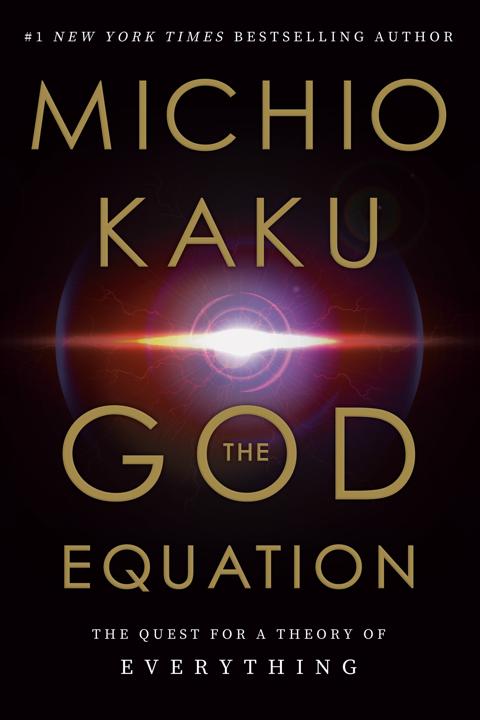Last updated on 2025/04/30
The God Equation Summary
Michio Kaku
Unifying Physics Through the Search for a Theory of Everything.
Last updated on 2025/04/30
The God Equation Summary
Michio Kaku
Unifying Physics Through the Search for a Theory of Everything.
Description

How many pages in The God Equation?
225 pages
What is the release date for The God Equation?
In "The God Equation," renowned physicist Michio Kaku takes readers on a mind-expanding journey through the quest for a unified theory that could unlock the secrets of the universe, often referred to as the "theory of everything." Delving into the intricate dance of quantum mechanics and general relativity, Kaku brilliantly explains how this elusive equation aims to weave together the forces of nature into a single, elegant framework, illuminating the fundamental truths of existence. With captivating insights and bold speculations about the future of physics, Kaku invites us to ponder profound questions that have tantalized scientists and philosophers alike: What is the nature of reality? How did the universe begin, and what lies beyond our comprehension? Join him in this exhilarating exploration that challenges the limits of human understanding and pushes the boundaries of scientific possibility.
Author Michio Kaku
Michio Kaku is an acclaimed theoretical physicist, futurist, and popular science communicator known for his extensive contributions to the fields of string theory and the unification of physics. As a co-founder of string field theory, he has played a significant role in advancing our understanding of the fundamental forces of nature. Beyond his academic accomplishments, Kaku is also a prolific author and speaker, bridging the gap between complex scientific concepts and the general public through his engaging writing and television appearances. With degrees from Harvard and an impressive tenure at universities like the City College of New York, he has become a prominent voice in science, inspiring audiences worldwide with his vision of the future and humanity's potential in the cosmos.
The God Equation Summary |Free PDF Download
The God Equation
Chapter 1 | UNIFICATION—THE ANCIENT DREAM
In the captivating first chapter of "The God Equation" by Michio Kaku, the author explores the profound human quest for understanding the universe and the unifying principles that govern it. This chapter chronicles the evolution of scientific thought, tracing the historical foundations laid by early philosophers and culminating in the groundbreaking achievements of scientists like Newton and Maxwell. The journey begins with a reflection on the beauty of the night sky, inspiring fundamental questions about existence and the universe’s design. Ancient Greek philosophers such as Aristotle and Democritus took significant strides in understanding the natural world. Aristotle's elemental framework of earth, air, fire, and water contrasts with Democritus's revolutionary idea of atoms, indivisible entities that constitute all matter. Democritus's indirect evidence of atoms, like the gradual wearing of a gold ring, hinted at a world much beyond mere observation—a practice still prevalent in modern science. Additionally, Pythagoras introduced the idea that mathematical structures can describe natural phenomena, suggesting a deeper order in the universe. This pursuit of fundamental unification faced setbacks during the Middle Ages but re-emerged during the scientific revolution, with figures like Giovanni Kepler, Galileo Galilei, and Isaac Newton challenging established norms to explore the cosmos. 1. Newton's Contributions: Newton established the first comprehensive framework for understanding the motion of terrestrial and celestial bodies. His realization that gravitational forces govern both apples and the moon laid the foundation for classical mechanics, which he adeptly described through mathematics, notably calculus. Newton’s significant contributions were marked by groundbreaking works like the "Principia,” where he unified the laws of motion and gravity into a singular theory, transforming scientific inquiry. 2. The Significance of Symmetry: Central to Newton's achievements is the concept of symmetry; his equations exhibit consistent behaviors regardless of orientation, a principle that continues to bear significance in unifying fundamental forces. This exploration of symmetry connects to broader ideas in physics and reveals underlying principles governing the universe. 3. Faraday and Maxwell: Following Newton, the chapter illustrates the immense contributions of Michael Faraday and James Clerk Maxwell in establishing the foundations of electric and magnetic phenomena. Faraday’s experimentation with fields introduced a new dimension, suggesting that electricity and magnetism are interconnected. Maxwell mathematically formalized this relationship, revealing that they could be unified under one theoretical framework, culminating in the understanding that light itself is an electromagnetic wave. 4. The Electric Age: The interplay of Maxwell’s equations with practical inventions sparked the electric age, changing communication and transforming society. The clash between alternating current (AC) championed by Nikola Tesla and direct current (DC) proposed by Thomas Edison exemplifies the application of scientific principles in addressing real-world challenges. The eventual success of AC not only revolutionized electricity transmission but also underscored the importance of mathematical understanding in technological advancements. 5. Incompatibility of Theories: The chapter concludes by suggesting that by the dawn of the 20th century, these foundational theories, while seemingly conclusive, were ultimately incompatible. This contradiction hinted that the prevailing scientific understanding would soon require reevaluation, and this critical shift would be ignited by a prodigious sixteen-year-old boy born in the same year Maxwell passed away—Albert Einstein. Overall, Kaku’s narrative successfully intertwines history, philosophy, and science, illustrating humanity's relentless pursuit of a universal understanding—an endeavor that continues to evolve as new discoveries challenge established paradigms. With clarity and depth, he presents a lineage of thought that not only shaped our comprehension of nature but also laid the groundwork for future breakthroughs in physics.
Key Point: The Ancient Dream of Unification
Critical Interpretation: Imagine standing under a sprawling night sky, contemplating the vastness of the universe and your place within it. The realization that humanity's quest for understanding has roots in ancient philosophical discussions reminds you that curiosity is a powerful driving force. This chapter invites you to embrace your own inquisitive nature, urging you to explore, question, and dream, just as those early thinkers did. The quest to unify different concepts, whether in science or in your everyday life, inspires you to connect seemingly disparate ideas and seek harmony in complexity. When faced with challenges, remember that the greatest discoveries often emerge from the courage to ask ‘why’ and the tenacity to seek answers, a journey that transcends time and space.
Chapter 2 | EINSTEIN’S QUEST FOR UNIFICATION
As a teenager, Albert Einstein pondered a profound question: Is it possible to outrun a beam of light? This seemingly simple inquiry would fundamentally transform the understanding of physics in the twentieth century, leading to his groundbreaking theory of relativity. Sparked by a children's book, he envisioned racing alongside a light beam, which he thought should appear stationary. However, this raised unsettling questions, prompting him to contemplate the nature of light and its behavior over the next decade—a period characterized by significant personal struggles and perceived failures. Despite being an exceptional student, Einstein faced criticism for his unconventional lifestyle and independent thinking, which resulted in him cutting classes and receiving poor recommendations from his professors. His subsequent job rejections left him despondent, and he even pondered selling insurance to support his family. Ultimately, he secured a low-level position at the patent office in Bern, where he found the time and mental space to revisit the question that captivated him since childhood. While working at the patent office, he encountered Maxwell’s equations that govern electromagnetism, compelling him to explore what would happen to these equations if one were to travel at the speed of light. To his astonishment, he discovered that the speed of light remains constant for all observers, a notion that contradicted Newtonian mechanics, which states that speeds can simply be added. This revelation led him to conclude that space and time themselves must be distorted to accommodate the consistent speed of light. Thus, time itself is not a fixed quantity but varies depending on one’s speed—an observation that laid the foundation for his theory of special relativity. 1. Time Dilation and Length Contraction: As an object approaches the speed of light, time slows down for that object relative to a stationary observer, leading to what is known as time dilation. Similarly, objects in motion experience length contraction, appearing shorter along the direction of travel from the perspective of an outside observer. Interestingly, those on the fast-moving object perceive themselves and their environment as unchanged. 2. Matter-Energy Equivalence: Einstein established the groundbreaking equation E = mc², which illustrates the equivalence of mass and energy. This concept not only transformed theoretical physics but also explained cosmic phenomena such as the sun’s fusion processes, where mass converts into energy. Moving beyond special relativity, Einstein sought a more comprehensive understanding by developing the general theory of relativity. He realized that gravity and acceleration are interrelated through what he termed the equivalence principle. This insight revealed that being in an accelerating reference frame (like an elevator in free fall) can create an experience identical to that of being in a gravitational field. 3. Gravitational Effects as Space Curvature: Instead of viewing gravity as a force that pulls objects together, Einstein proposed that massive bodies warp the fabric of space-time. Consequently, the apparent force of gravity results from this curvature of space. For instance, a marble rolling on a curved surface will move in an ellipse as it follows the distorted terrain created by a heavier object, much like planets orbiting stars due to the warping of space around them. 4. Experimental Verification: Einstein's theoretical work culminated in consequential predictions, which demanded experimental validation. One prominent test was the eccentric orbit of Mercury, which exhibited anomalies in its perihelion. His calculations aligned precisely with observed data, marking a significant triumph over conventional Newtonian predictions. Furthermore, during the 1919 solar eclipse, his hypothesis predicting light bending by gravity was confirmed through astronomical observations, earning him acclaim and a Nobel Prize. As general relativity gained acceptance, it emerged as a revolutionary framework that not only explained gravitational phenomena but also unified the fabric of space and time as a dynamic entity affected by mass. This contrasted notably with the static essence of Newtonian physics, and advocates who adopted Einstein’s ideas were often scrutinized by traditionalists. 5. Legacy and Critiques: As Einstein's theories reshaped physics, his lifelong quest for a unified theory to encompass electromagnetism and gravity remained elusive. His reluctance to fully embrace quantum mechanics, despite contributing to its foundation, put him at odds with much of the scientific community. Nonetheless, the tests and implications of his theories continue to be confirmed experimentally, solidifying his status as a pillar of modern scientific thought. Ultimately, both Einstein and Newton demonstrated immense intellectual prowess focused on solving complex problems but differed vastly in their personalities and social attributes. Their contributions encapsulate pivotal moments in human understanding, ultimately shaping our perception of the universe and laying the groundwork for future scientific exploration.
Key Point: Curiosity as a Catalyst for Discovery
Critical Interpretation: Imagine standing in the shoes of a young Albert Einstein, bursting with questions yet feeling the weight of the world's expectations. His insatiable curiosity pushed him to challenge established conventions and seek the elusive truth about the nature of light and gravity. This relentless pursuit teaches us that curiosity is not just a childhood trait; it is a powerful catalyst for discovery and growth. In our lives, whether grappling with personal challenges or professional hurdles, embracing a curious mindset can inspire bold exploration and innovative solutions. Just as Einstein transformed his frustrations into revolutionary insights, you too can turn your questions into pathways that lead to profound understanding and transformative change.
Chapter 3 | RISE OF THE QUANTUM
In the transformative landscape of physics during the early 20th century, two paramount developments emerged: Einstein's theory of relativity and the burgeoning field of quantum mechanics, each setting the stage for a profound understanding of the universe. As Einstein was adapting our understanding of space and time, scientists were passionately unraveling the fundamental nature of matter — its constituents and behaviors — culminating in the birth of quantum theory. 1. The Journey of Matter’s Understanding: The quest to decipher the nature of matter began centuries prior, moving from Newton's alchemical pursuits to the systematic isolation of elements in the 19th century. Dmitry Mendeleyev’s vision of the periodic table revolutionized this domain, revealing an intrinsic order among elements, which highlighted missing pieces yet to be discovered. This organizational breakthrough enabled predictions regarding undiscovered elements, cementing Mendeleyev’s legacy. 2. Discovery of Radioactivity: The Curies' isolation of radium in 1898 challenged the notion that elements were immutable. Their findings that unstable elements decay over time, releasing energy, led to a seismic shift in understanding the age of the Earth. The implications were enormous; geologists adjusted their views, recognizing that Earth's history spanned billions of years, influenced by newly identified forces such as nuclear decay, underscoring a dynamic, rather than static, view of matter. 3. Rutherford’s Groundbreaking Experiments: Ernest Rutherford’s gold foil experiment exposed a key revelation: atoms are primarily empty space. This radically recast the perception of atomic structure from a compact, solid form to one that is largely vacuous, with a tiny, dense nucleus at its core housing protons and neutrons. 4. Emergence of Quantum Mechanics: A pivotal shift occurred as physicist Max Planck delved into the nature of emitted radiation from hot objects. His hypothesis posited that energy manifests in discrete packets, dubbed quanta. This idea birthed quantum theory, radically challenging classical views of continuous energy and laying foundational concepts for future experiments. 5. Wave-Particle Duality: Later developments introduced duality into our understanding of light and matter. Einstein's introduction of photons redefined light as exhibiting both wave and particle characteristics. This principle extended to electrons, exemplified through interference patterns in the double-slit experiment, which revealed that particles could also exhibit wave-like phenomena. This led to the profound realization that particles, such as electrons, do not possess definite locations until measured, highlighting the probabilistic nature of quantum mechanics. 6. Schrödinger’s Equation and Structure of Matter: Erwin Schrödinger's wave equation formalized the behavior of electrons around the nucleus, providing a mathematical tool to explain atomic structures and laying out patterns observable in the periodic table. This work underscored the wave properties of electrons and the resulting discrete energy states they occupy. 7. Dirac’s Relativistic Equation: Paul Dirac further advanced quantum theory by integrating special relativity with new formulations of wave mechanics. His plasma of elegance yielded groundbreaking results, predicting the spin of electrons — a property that plays a significant role in magnetism, and foreshadowing the existence of antimatter, expanding the known parameters of physics. 8. Debate on Quantum Interpretations: The philosophical implications of quantum mechanics fostered intense debates, notably between Einstein and Niels Bohr, who emphasized the inherent uncertainties in quantum predictions. Einstein, a proponent of determinism, grappled with the notion that probability could dictate reality, famously asserting that “God does not play dice with the universe.” The discussions culminated in Schrödinger's cat thought experiment, illustrating the paradoxes of quantum states and the significance of observer influence on reality. 9. Uncovering Stellar Composition: As quantum mechanics matured, it validated scientific methods to deduce the composition of celestial bodies. Utilizing spectroscopy, scientists like Joseph von Fraunhofer identified that stars, including our sun, were primarily hydrogen, reshaping our understanding of stellar behavior and thermodynamics. 10. World War II and the Atomic Race: World events, notably World War II, compelled physicists to turn their focus toward the potential of atomic energy as a weapon. The realization that nuclear fission could produce devastating energy led to the urgent development of atomic weapons through projects like the Manhattan Project, while European scientists faced persecution and displacement under oppressive regimes. 11. Aftermath and Future Directions: As discussions transformed into practical applications of quantum theory in weaponry and energy, physicists sought to resolve lingering questions about the complete nature of matter. The progress made during this turbulent period highlighted quantum physics not merely as an intellectual pursuit but fundamental to understanding both the cosmos and technology's role in modern civilization. In conclusion, the rise of quantum theory not only revolutionized our comprehension of the microscopic world but also posed deep philosophical inquiries regarding determinism, existence, and the very fabric of reality itself. Today’s understanding of matter and energy stands as a testament to this remarkable journey, intertwining scientific inquiry with the profound complexities of the universe.
Key Point: The chapter highlights how our understanding of matter—from atoms to subatomic particles—has evolved through curiosity and scientific discovery.
Critical Interpretation: This reminds us that continuous exploration and questioning lead to profound insights about the universe, inspiring us to stay curious and open-minded in our own pursuits.
Chapter 4 | THEORY OF ALMOST EVERYTHING
In Michio Kaku's exploration of “The God Equation,” Chapter 4, titled "Theory of Almost Everything," he delves into the evolution of physics following World War II. The narrative begins with Albert Einstein, a figure who, despite his monumental contributions to the understanding of matter and energy, felt isolated as the scientific community became increasingly engrossed in quantum theory rather than unified field theory. This shift fostered sentiments of inadequacy within Einstein, who believed he had been left behind in a field that had moved on without him. His aspiration to articulate a guiding principle for a theory of everything was never realized, leaving a puzzle at the core of theoretical physics that persists today. 1. Quest for Unified Theory: After Einstein, various physicists made attempts to unify the fundamental forces of nature, including Erwin Schrödinger and Wolfgang Pauli, who offered their interpretations of unification. Pauli, known for his cynicism, raised doubts about humanity's ability to recreate a unified force, famously suggesting that some forces were irreparably divided. The field of quantum electrodynamics (QED) emerged as a major breakthrough, combining light and electrons while also showcasing the challenges of infinite calculations within quantum mechanics. 2. Renormalization: The discovery of QED came with the development of renormalization theory, introduced independently by Richard Feynman, Julian Schwinger, and Shin’Ichiro Tomonaga. This theory operates under a controversial premise: by accepting that certain quantities are infinitely large, physicists could effectively cancel these infinities to produce finite, usable results. Despite its convoluted nature and the complexity it brought into physics, renormalization became the foundation for a series of technological advancements, giving rise to technologies like transistors and lasers. 3. Understanding Life through Quantum Mechanics: Schrödinger’s inquiries into life challenged traditional dualistic views, proposing that genetic information resides not in a spiritual realm but within molecular structures governed by quantum mechanics. His seminal work inspired Watson and Crick to decode DNA, revealing how genetic information transmits life. This landmark achievement, facilitated by quantum techniques, underscored that biology and quantum physics are intertwined realms working to unlock nature's mysteries. 4. Complexity of Nuclear Forces: On the heels of understanding electromagnetic forces, physicists grappled with the nuclear forces—the strong and weak interactions that hold atomic nuclei together. Particle accelerators were developed to explore these forces, revealing a plethora of subatomic particles that bewildered physicists. Gell-Mann's introduction of quarks established a framework to understand the strong force, while research into the weak force necessitated new particles, such as the elusive neutrino. 5. The Standard Model: The culmination of these efforts led to the establishment of the Standard Model, which effectively unified three fundamental forces: electromagnetism, the weak nuclear force, and the strong nuclear force. However, it fell short on several fronts. It failed to incorporate gravity, was complicated by the presence of numerous undetermined parameters, and included redundant generations of particles. The quest for a unified theory remained incomplete, notably at the intersection of the quantum realm and gravitational physics. 6. Challenges with Gravity: Attempts to merge gravity with quantum mechanics proved immensely challenging. Early efforts to introduce the graviton as a quantized particle of gravity encountered insurmountable difficulties, with the quantum corrections for gravity revealing unresolvable infinities. This crisis signified a major obstacle in the field, leading physicists back to theories involving quantization without directly incorporating gravity. 7. Cosmic Phenomena and the Future of Physics: As research progressed, the quest expanded to address extraordinary concepts like black holes and dark matter. These revelations posed significant theoretical challenges and underscored the limitations of existing models. The narrative concludes with a recognition that physicists are only scratching the surface of understanding the cosmos, compelling a collaborative effort towards an all-encompassing theory capable of marrying the sub-atomic intricacies with the vast cosmic phenomena. In summary, "Theory of Almost Everything" illustrates the arduous journey toward a unified understanding of the universe—a path laden with intellectual triumphs and daunting paradoxes. The chapter reflects hope for future endeavors that may yet reveal the deep interconnections between the forces of nature.
Key Point: The development of quantum electrodynamics (QED) demonstrated that, even in the face of complex infinities and artificial solutions like renormalization, scientists could achieve highly accurate predictions by perseverance and innovative thinking.
Critical Interpretation: This teaches you that embracing challenges and daring to explore unconventional approaches can lead to groundbreaking advancements, inspiring you to persist through difficulties in your own pursuits.
Chapter 5 | THE DARK UNIVERSE
In 2019, astronomers achieved a remarkable milestone by capturing the first-ever photograph of a black hole, located in the galaxy M87, a staggering 53 million light-years from Earth. This colossal black hole, with a mass five billion times that of the sun, sparked widespread fascination not only among physicists but also in popular culture, becoming a focus of significant media attention. The imaging was made possible through an innovative method that combined data from five radio telescopes around the world, creating a telescope with Earth-sized capability, best illustrated by its ability to detect an object as small as an orange on the moon from our planet. 1. The exciting resurgence in research related to Einstein's general relativity has revived discussions surrounding the nature of gravity, especially given that previous decades had seen limited advancements. The equations governing general relativity are notoriously difficult, complicating experimental validation. However, the merging of quantum theory with general relativity has led to a renaissance of scientific breakthroughs in understanding gravity. 2. The conceptual foundations of black holes trace back to Isaac Newton's gravitational laws, which explain that an object could escape Earth’s gravity by achieving a specific velocity known as escape velocity. Notably, 18th-century astronomer John Michell proposed the idea of "dark stars," suggesting that if a star's escape velocity exceeded the speed of light, light itself could not escape, rendering the star invisible. 3. The path to modern black hole theory includes pivotal contributions from scientists like Karl Schwarzschild, who, in 1916, found solutions to Einstein’s equations that described black holes. His work revealed that beyond a threshold known as the event horizon, gravity becomes so intense that escape is impossible. 4. Black holes are categorized mainly into two types: those formed from the remnants of massive stars and the much larger supermassive black holes found at the centers of galaxies. Observations suggest that nearly all galaxies host such supermassive black holes. 5. Stephen Hawking made groundbreaking advancements by merging quantum physics with black hole theory. Despite his debilitating illness, he postulated that black holes must emit radiation (now termed Hawking radiation), which implies that they can eventually evaporate. This radiation arises from quantum fluctuations in vacuum energy, leading to the intriguing conclusion that particles can escape from black holes. 6. A contentious topic in the realm of black hole physics concerns the fate of information once it crosses the event horizon. Hawking stirred debate by proposing that information is irretrievably lost in black holes, whereas subsequent discussions suggest that such information could be preserved within Hawking radiation itself. 7. The conversation surrounding black holes also entails the existence of wormholes, theoretical bridges connecting disparate points in spacetime. Initially proposed by Einstein and further developed by mathematicians like Roy Kerr, these hypothetical constructs could potentially allow for inter-universal travel or shortcuts within our universe. 8. Time travel, long a subject of science fiction, remains a nascent area in physics, particularly as the implications of general relativity and quantum mechanics collide. Various solutions to Einstein’s equations suggest means by which time travel might be conceived, though paradoxes loom large in theoretical explorations. 9. The universe's origin has philosophical and scientific implications, prompting debates on concepts like the Big Bang and the nature of cosmic expansion. While Edwin Hubble's discoveries indicated that the universe is expanding, further analysis unveiled mysteries surrounding its acceleration attributed to dark energy—a substance both elusive and foundational to modern cosmology. 10. Many unresolved questions persist within theoretical physics, particularly relating to the unification of quantum mechanics and general relativity—a pursuit that continues to drive research. As scientists grapple with concepts like gravitons and the mathematical nature governing these entities, the overarching goal remains a cohesive theory that elucidates the fundamental forces shaping our universe. Exploration of black holes, time travel, and cosmic origins encapsulates the profound challenges that modern physics faces, with the intertwining of theoretical discussions likely leading to groundbreaking advancements in the quest to uncover the 'God Equation'—a unified understanding that could elegantly describe the myriad phenomena of the universe.
Key Point: The image of the black hole as seen in 2019 demonstrates humanity's remarkable progress in observational technology and understanding of the universe.
Critical Interpretation: This achievement can inspire you to believe in the power of human ingenuity and perseverance, encouraging you to pursue your own goals despite obstacles, knowing that even the most mysterious aspects of our universe can be unveiled through dedication and innovation.
Chapter 6 | RISE OF STRING THEORY: PROMISE AND PROBLEMS
Chapter 6 of "The God Equation" by Michio Kaku reflects on the evolution and challenges of string theory, which aims to unify two fundamental pillars of physics: Einstein's theory of gravity and quantum theory. The narrative begins with a historical perspective where, around the year 1900, physics revolved around Newton’s laws and Maxwell's equations for light, both of which eventually collided, prompting a revolutionary shift in scientific thinking. Fast forward to the present, and we find ourselves facing a similar predicament with gravity and quantum mechanics, each standing on different mathematical and philosophical grounds. The inception of string theory in 1968 by physicists Gabriele Veneziano and Mahiko Suzuki marked a turning point, as they discovered a mathematical formula that described particle collisions in a novel way. The connection made between this old formula and particle interactions led to the realization that the interactions could be modeled as oscillations of strings. Soon after, efforts to connect this new theoretical framework with spinning particles established string theory as a fertile ground for generating a plethora of new equations. 1. One of the most compelling aspects of string theory is its intrinsic inclusion of gravity, as the graviton—responsible for gravitational interactions—naturally arises as a vibration of a string. The argument that gravity is fundamental to string theory, despite the historical challenges of reconciling it within quantum field theories, has made string theory notably attractive to physicists. 2. As string theory progressed, it revealed unexpected features, such as the conclusion that it exists only in a ten-dimensional framework. Initially met with skepticism, this idea was difficult to accept as physicists have predominantly operated under the assumption of a four-dimensional universe. Yet, further scrutiny indicated that rival theories faced severe issues, leading many to reconsider the ten-dimensional premise's validity. 3. The emergence of string field theory represented a shift toward reconciling string theory with the well-established language of fields. Kaku and his colleague Keiji Kikkawa demonstrated that string theory could be expressed more cohesively, linking the seemingly chaotic equations into a more elegant structure. 4. A significant breakthrough came with the introduction of supersymmetry, a refined symmetry that relates fermions—matter particles—and bosons—force carrier particles. This symmetry had profound implications, allowing string theory to cancel destructive infinities arising from quantum corrections, offering a finite framework for quantum gravity. 5. The narrative continues with the intriguing idea that supersymmetry not only provides a unifying framework but also suggests the existence of superpartners for every particle, integrating a vast array of particles into a coherent structure. As string theory developed, it catalyzed the exploration of various dimensions and dualities, particularly highlighted by the emergence of M-theory in the mid-1990s, which posited an eleven-dimensional framework from which five distinct ten-dimensional string theories could be derived. This reconciling of theories has led to meaningful discourse on the nature of our universe, including revolutionary ideas such as the holographic principle, where two-dimensional information holds knowledge about three-dimensional objects. 6. However, string theory is not without its criticisms. It faces ongoing challenges regarding its testability; the scales at which its effects would be observable lie beyond current experimental capabilities, causing some prominent physicists to question its scientific validity. The theory suggests an infinite landscape of possible universes, complicating any attempt to derive unique predictions about our own universe. 7. Nonetheless, there are pathways towards potential validation, including the search for dark matter and opportunities for future particle accelerators that might uncover evidence of mini black holes or supersymmetric particles. The dialogue reflects collective hope that the theory's mathematical elegance will eventually translate to physical reality, despite the inherent complexities. Ultimately, Kaku illustrates the dynamic journey of string theory, its promise for unification, and the profound philosophical implications it raises about the universe, its origins, and the quest for understanding our place within it. The chapter ends with reflection on the theory’s potential to bring clarity to the fundamental aspects of reality even as it leaves an open question about the ultimate meaning or purpose behind the cosmos.
Key Point: The Unifying Quest of Theoretical Physics
Critical Interpretation: Imagine embarking on a quest to uncover the shared truths that lie hidden beneath the surface of seemingly conflicting concepts. In Michio Kaku’s exploration of the challenges in merging general relativity with quantum theory, you are reminded that true progress often comes from embracing complexity and seeking unity amid diversity. Just as physicists endeavor to harmonize contrasting theories, you can draw inspiration for your own life by understanding that challenges, conflicts, and differing perspectives—whether in relationships, work, or personal growth—can lead to innovation and profound insights. Instead of shying away from difficult conversations or dismissing opposing viewpoints, allow them to enrich your understanding, propelling you towards a more comprehensive perspective of the world. Each layer of complexity you encounter is not an obstacle, but rather a stepping stone towards a greater synthesis of ideas, fueling your journey towards self-discovery and connection.
Chapter 7 | FINDING MEANING IN THE UNIVERSE
In the exploration of the universe's meaning, we begin by understanding how mastery over the four fundamental forces—gravity, electromagnetism, and the interactions described by quantum physics—has been pivotal in shaping human civilization. From Newton's foundational laws of motion to Einstein's intricate frameworks, these scientific advancements have revolutionized our understanding of reality and fostered significant technological progress. Assuming the existence of a unified theory that encompasses all fundamental forces, we must consider its implications on our lives. While the practical effects on daily existence may be negligible—due to the immense energy scales involved, transcending ordinary human experience—the theory could profoundly influence our philosophical perspective on existence. Questions that have perplexed philosophers for centuries, such as the nature of time travel or the origins of the universe, could find resolution within this framework. 1. The quest for meaning in the cosmos leads us to contemplate deep existential inquiries, reminiscent of sentiments from thinkers like Thomas H. Huxley. The complex interplay between humanity and the universe evokes fundamental inquiries about our purpose and the overarching design, questioning whether the universe has inherent meaning or if we must derive our significance independently. Einstein himself grappled with these existential dilemmas, acknowledging his inability to provide definitive answers regarding life's purpose or the existence of a deity. He delineated between a personal God—who intervenes in human affairs—and the Spinozan conception of God, representing an elegant order within the universe. Einstein saw this cosmos as a grand library filled with knowledge, the contents of which remain largely unreadable to humanity, which compels us to question if any higher authority exists. 2. The discourse around the existence of God then delves into historical theological arguments, including St. Thomas Aquinas's influential proofs. The cosmological argument postulates a First Cause for existence, while the teleological argument suggests a designer due to the complexity of life. The ontological argument claims that the very definition of God as a perfect being necessitates existence. Importantly, evolving scientific understanding prompts reexamination of these age-old assertions in light of contemporary cosmology and quantum mechanics. While evolutionary processes can rationalize the apparent design in nature, the cosmological argument retains relevance as we confront the origins of existence itself. The multiverse theory, suggesting countless universes coexisting, raises further questions: where did this multiverse come from, and how does it relate to the fundamental laws defined by a potential theory of everything? 3. Einstein’s inquiries about the universe’s uniqueness illustrate a profound irony; the simplest explanations can often lead to the most complex mysteries. The theory of everything may not only suggest a mathematical consistency but possibly a higher intelligence behind its formulation. The intricate balance of physical laws hints at underlying truths yet to be revealed, akin to searching for a symphony within a cacophony. Despite the intricacy of scientific investigation, certain philosophical questions, such as why there is something rather than nothing, remain elusive. Quantum fluctuations in “Nothing” offer speculative insights into the Big Bang's origins, suggesting that the universe may originate from quantum events within vacuums. 4. The idea of meaning extends beyond cosmic design; it resides within personal experience and struggle. Reflecting on teachings from various philosophical and spiritual traditions, including Christianity and Buddhism, we find opposing views on the universe's inception. The multiverse theory, describing ongoing creation within a broader context, indeed offers a synthesis of these dichotomous beliefs. Ultimately, the notion of constructing our own meaning becomes central. Life's significance may not stem from predetermined conclusions but rather through individual journeys of discovery and mindfulness amidst life's transient nature. Even as we acknowledge a potential eventual demise of the universe, where all life and meaning could seemingly dissipate, there remains hope for rebirth and transformation through technological advancement. In conclusion, the theory of everything encapsulates not just a mathematical elegance but potentially harbors profound answers regarding our universe's fabric and our place within it. As we continue to unravel the mysteries of existence and grapple with foundational questions, we draw closer to a collective understanding of our role in an ever-expanding cosmos. Thus, the journey towards comprehension may ultimately be as significant as the answers we seek.
Key Point: Embracing Uncertainty
Critical Interpretation: In the journey of life, when you embrace uncertainty, you open yourself up to endless possibilities and discoveries. Just as scientists venture into the unknown, allowing the mysteries of the universe to challenge their understanding, you too can find inspiration in the uncertainties of your own existence. This perspective empowers you to explore new paths, confront your fears, and welcome change, recognizing that within every unanswered question lies the potential for growth and insight. Instead of seeking rigid certainties, you might find that the beauty of life is in its unpredictability. Like the universe itself, your journey can unfold in surprising and profound ways, leading you toward a more fulfilling and authentic self.










